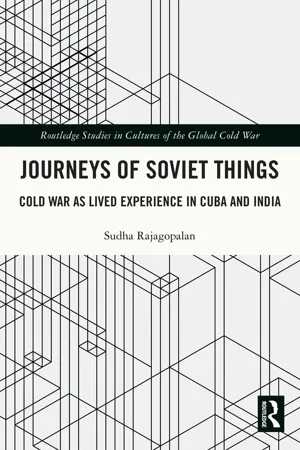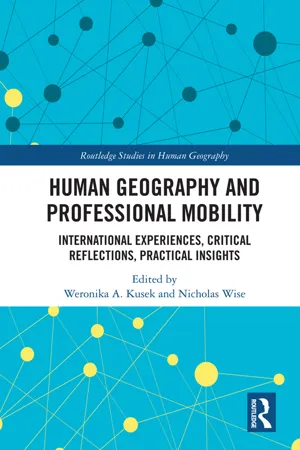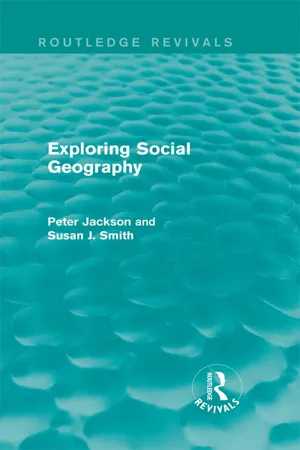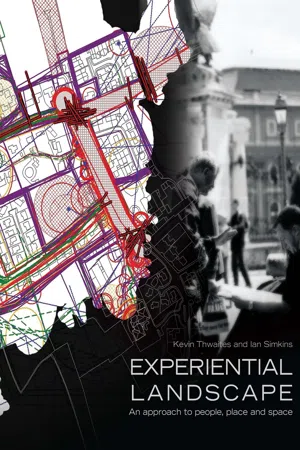Geography
Lived Experience
"Lived experience" refers to the unique and subjective understanding of the world based on an individual's personal encounters and interactions with their environment. In geography, this concept is important for understanding how people perceive and interact with the spaces and places around them, and how these experiences shape their sense of identity and belonging within different geographical contexts.
Written by Perlego with AI-assistance
Related key terms
Related key terms
1 of 4
Related key terms
1 of 3
5 Key excerpts on "Lived Experience"
- eBook - ePub
Journeys of Soviet Things
Cold War as Lived Experience in Cuba and India
- Sudha Rajagopalan(Author)
- 2023(Publication Date)
- Routledge(Publisher)
Plamper 2015 , 289). Interlocutors tell stories, and as such they narrate and give coherent form to a selection of memories for the purpose of the interview. The Lived Experience I hear about is what is crafted as such and is thus subject to the vagaries of memory; it is those aspects of the Lived Experience that the interlocutor thinks is relevant for the conversation. Below I consider this and other conceptual ‘ins’ that help us do a history that foregrounds Cold War history as Lived Experience.Emotions and affect
An impulse to study Lived Experiences allows a segue into emotional geographies, underscoring how emotions underpin political mobilisation and imaginaries, and help structure narratives of historical experience. Emotions are an inner state of being which we then construct and articulate in culturally specific ways. Perhaps most usefully, it is no longer seen as incompatible with ‘reason’ but ‘essential to rationality’ (Mercer 2006 , 289–290). Because our emotions shape our choices, utterances, interactions and our very existence (Smith et al. 2009 , 2), they permeate our ideas about the world, about how we fit in it, and inform our acts and gestures in that world. Emotions inflect geopolitical imagination and yet we tend to pay no heed to these.Affect goes beyond emotion to suggest a pervasive feeling, something that is not articulated but nevertheless felt. Emotions are socially and culturally expressed; affect is something that has been variously described as biological, physiological, or as ‘felt atmosphere.’ This latter is the more persistent quality to how interlocutors talk about Soviet things. Because they associate them either with important transitional and transformative moments in their lives or with their memory of a past period that both personally and politically felt more secure, there is a constant allusion to feelings in interviews. These feelings can be positive, or may simply constitute a ‘sense’ that goodwill was present. This latter is articulated as something that ‘hung in the air’ or felt in the atmosphere (Brennan 2004 , 1). Sara Ahmed writes that emotions are not something one has but something that circulates, and to which we may all react differently (Ahmed 2004 , 10). In other words, when interlocutors say that there was a ‘sense’ that Soviets were friends, it is also not necessarily a personal emotion but more a pervasive sentiment or affect that circulates beyond the subject; something that is “intermittent,” switches between “foregrounding and backgrounding” and is “flickering” (Merriman and Jones 2017 - eBook - ePub
Human Geography and Professional Mobility
International Experiences, Critical Reflections, Practical Insights
- Weronika Kusek, Nicholas Wise(Authors)
- 2019(Publication Date)
- Routledge(Publisher)
1 Experience, mobility, professional narratives, and human geographyWeronika A. Kusek and Nicholas WiseIntroduction
Geography is the study of the land and how we use it, broadly considering space, place, movements, and human-environmental interactions. Human geography specifically is concerned with how humans influence their surroundings, how they interact within space, and how they change landscapes, and complexities are added when we consider local, regional, national, and international scales (Malinowski and Kaplan 2012). Human geography textbooks include and frame debates of concepts such as place and space, language, religion, migration, urban patterns, and agriculture, but missing are personal accounts from real geographers of their experiences with these concepts. A collection of critical narratives will contribute new accounts of individual experiences in/from the field, based on real stories of how professional geographers navigate space while trying to assimilate in a new place. The purpose of this book is to encourage, influence, and help students grasp the depth of geographical concepts, based on critical reflections, international experiences, and practical insight. The value of this book is based on two main premises. First, there is general demand for materials and readings to support foundational geographical courses, which are either requirements or supplemental courses in many social sciences, liberal arts, and scientific majors. Second, specifically for this book, in our experience we found that students directly benefit in their learning by exploring geographical concepts through relatable and inspiring perspectives. This book presents deep, compelling, and creative ways to explore geographical concepts.This book explains geographical concepts using real/personal stories by geographers to which students can relate. Critical insights are explained and explored based on accounts that are autobiographical, original, and personal. The book tells personal stories of geographers who reflect on their experiences in the field. While telling their stories to the reader, the authors incorporate the terminology that students learn in human geography classes such as place, push factors, pull factors, ethnicity, nationality, religion, folk culture, ethnic neighborhoods, expats, and other terms. The authors use themselves and their fieldwork experiences as examples to explain geographical concepts. For example: what were the pull factors for their adventures, how they turned spaces (apartments that they rented) into places (that have meaning, where social interaction happens), experiences from when they visited ethnic neighborhoods (e.g., a Polish immigrant visiting a Polish neighborhood in London), etc. This edited volume of critical narratives illustrates the trajectories of selected geographers who work at American and international institutions and who conduct research internationally on global issues. The authors offer critical navigations of spaces while searching for answers to geographical questions. - eBook - ePub
- Alan A. Lew, C. Michael Hall, Allan M. Williams, Alan A. Lew, C. Michael Hall, Allan M. Williams(Authors)
- 2014(Publication Date)
- Wiley-Blackwell(Publisher)
more-than-representational geographies, brings out and delves into the relationship of the tourist with the visited landscape, through lived, interactive experience (Lorimer, 2005), with an emphasis on sensescapes and emotions/affect, tied to place and landscape. The proliferation of critical, posthumanist, poststructuralist, and postmodern perspectives and insights into landscapes of tourism has opened up their study beyond traditional scientific boundaries, and rendered the broader field under study here distinctly more interdisciplinary, multidisciplinary, and transdisciplinary. However, as this chapter continues to argue, intersubjective, embodied, and multisensual tourism performance in the landscape needs to be played out in more complexity and the tourist's encounter with space, generally speaking, developed further.The Place of Landscape in Tourism Geography: A Critical Assessment
On the Relationship of Tourism and Landscape
On the basis of its both tangible and intangible character, landscape constitutes a most significant geographical medium in the analysis of relationships that develop between tourist and visited location. The readiness and amenability of landscape to variable human intervention transform it into a veritable stage for play and recreation (Carmichael, 1998). As a geographical medium conceived and appropriated through the senses and the power of cognition and symbolism, landscape represents the first and most enduring medium of contact between tourist and prospective or consumed place of travel; through acquired photographs, it becomes a traveler's lasting memoir. Tourist landscapes, moreover, through promotion, sustenance, and transformation of their specific functions, are among the most significant and conflictual cultural grounds in the formation of identity and the negotiation of development (Terkenli, 2000). The importance of the role of tourism for identity formation in the landscape comes through the multiplicity of contextualized tourist knowledges and imaginaries, in dialectical relationship with place and the landscape (Figure 22.1 - eBook - ePub
- Peter A. Jackson, Susan J. Smith(Authors)
- 2014(Publication Date)
- Routledge(Publisher)
As we have already suggested, however, it is the combination of a subjectivist perspective with a firm grounding in material existence that makes existential phenomenology most attractive to social geography. Its conceptions are generally less obscure than those of either philosophy in its purest form. We shall deal briefly with some of them, seeking illustrations from the geographical literature which claims phenomenological inspiration.Intersubjectivity and the geographical ‘lifeworld’Among the concepts of most direct relevance to social geography in phenomenological writings are the concepts of ‘lifeworld’ and intersubjectivity. The lifeworld can be defined as the taken-for- granted world of everyday living and thinking, and our experience of it comprises the ‘facts’ which phenomenology aims to explore. Buttimer (1976) has written of the social geographer’s task in terms of ‘grasping the dynamism of lifeworld’, and Ley (1977) has directed specific attention to the ‘taken-for-grantedness’ of this lifeworld, which he defines as an intersubjective world of Lived Experience and shared meanings. He argues that the ‘personality of place’ is derived from the coherence of such intersubjective experience: ‘any habitually interacting group of people convey a character to the place they occupy which is immediately apparent to an outsider, though unquestioned and taken-for-granted by habitués’ (Ley 1977, p. 508).This pre-reflective, pre-intellectual, world of experience has been the subject of much of Yi-Fu Tuan’s writings (1974a, 1977, 1980). By making the apparently mundane experiences of the lifeworld the specific focus of inquiry, phenomenologists have drawn attention to previously unconsidered (‘taken-for-granted’) aspects of our personal geographical environment. Seamon has attempted to generalise some of these elements (movement, rest, and encounter) in his pioneering and controversial work A geography of the lifeworld (1979). This work also considers the phenomenological critique of other research orientations in behavioural geography. With reference to Merleau-Ponty’s Phenomenology of perception (1962), for example, Seamon develops a critique of a priori theories of behaviour based on stimulus-response models and the notion of environmental ‘images’. He rejects both models, stressing the precognitive basis of everyday movement. When driving a car, for example, one generally changes gear pre-reflectively, not as a conscious cognitive response to some stimulus from the external environment. Similarly, when making a familiar journey, one is not consciously governed by any mental ‘image’ of the route. In each case, Seamon revives Merleau-Ponty’s notion of body-subject , according to which the body holds within itself an active, intentional capacity. From this notion, Seamon builds up, albeit in rather pretentious vocabulary, the geographically significant concepts of time-space routines and place-ballets - eBook - ePub
Experiential Landscape
An Approach to People, Place and Space
- Kevin Thwaites, Ian Simkins(Authors)
- 2006(Publication Date)
- Routledge(Publisher)
Urban Design Compendium (2000) developed in association with English Partnerships provides an example. Of particular relevance here are messages implicit in this arena suggesting that certain spatial configurations may be beneficial to human experience of the external environment, the practical implications of which are hitherto not explored.Up to now we have been concerned with theoretical grounding, an intellectual and academic justification for developing experiential landscape as a way to conceptualise people-space relations in the routinely encountered outdoors. At the heart of experiential landscape is a commitment to the idea that human experience has spatial dimensions and we have tried to present some justification for this view. Experiential landscape is, though, more than a field of academic inquiry. We are also interested in investigating how to apply the philosophical and theoretical principles that underpin experiential landscape in practice. Partly this means finding ways to understand the experiential character of outdoor settings through interpretation of spatial organisation and working out what components and procedures of design processes might help to make experientially better places. Space is arguably a fundamental medium for those who design outdoor settings and the sculpting and moulding of space and the material elements that define it are central to their purpose. The concept of experiential landscape responds with a conceptual framework setting out how certain categories of human experience can be interpreted spatially. This has helped develop and consolidate our ideas about how outdoor places can be understood holistically as four spatial types called centre, direction, transition and area, which combine in an infinity of ways to make places of different experiential character. Centre, direction, transition and area can be thought of as a kind of code representing the spatial expression of these experiences in the outdoors and, through knowing something of their properties and characteristics, makes it possible to read the experiential profile of existing settings and, although to a more limited extent, those still in the planning and design process. This model provides the basic structure upon which to begin to build the components and procedures required to apply experiential landscape principles in practice and this is what this section will sketch out. Before doing so, however, we want to say a few things about why the concept of experiential landscape is structured as it is.
Index pages curate the most relevant extracts from our library of academic textbooks. They’ve been created using an in-house natural language model (NLM), each adding context and meaning to key research topics.
Explore more topic indexes
Explore more topic indexes
1 of 6
Explore more topic indexes
1 of 4




